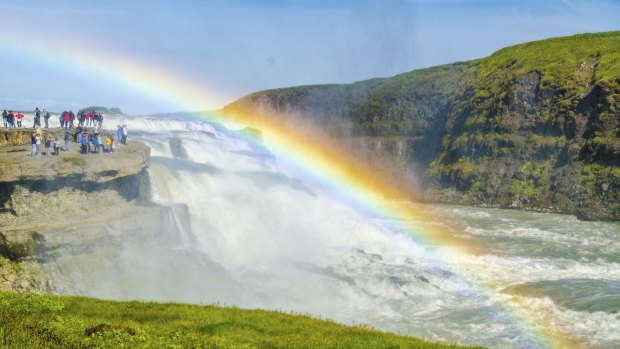
Gullfoss Waterfall in Iceland.Credit: iStock
"Can you smell it?" The question circulates among our tour group as we filter out of our air-conditioned minibus and into a bleak, boulder-strewn Mordor-esque landscape punctuated with simmering steam plumes. A few people instinctively hold their noses. Others screw up their faces. I do both. No words are necessary. Yes, we can definitely smell it; the sulphur, that is.
It's the first time today that we've encountered this rotten eggy scent, but it won't be the last. Sniffing sulphur is par for the course when exploring Iceland, an island of tempestuous tectonic activity marooned in the North Atlantic Ocean, where the diverging North American and Eurasian plates spark all manner of weird, wonderful and occasionally worrying natural events (such as the ash-spewing eruption of Eyjafjallajokull, which shut down much of Europe's airspace in 2010, and the ongoing rumbling of Bardarbunga volcano beneath Vatnajokull, Iceland's largest glacier).
Yet Iceland's geological volatility - and curious aromas - haven't deterred outsiders. Quite the opposite. Since Eyjafjallajokull blew its top, visitor numbers to Iceland have doubled; the country now attracts a million foreign tourists annually (more than three times its population). This influx has provided a much-needed boost to an economy that was on its knees after the 2008 Global Financial Crisis. "I'm thrilled tourism is growing in Iceland, but I miss having the place to myself," (half) jokes Jeff Thomson, our ebullient Canadian guide, who has been leading tours around this so-called 'Land of Ice and Fire' since 2001.
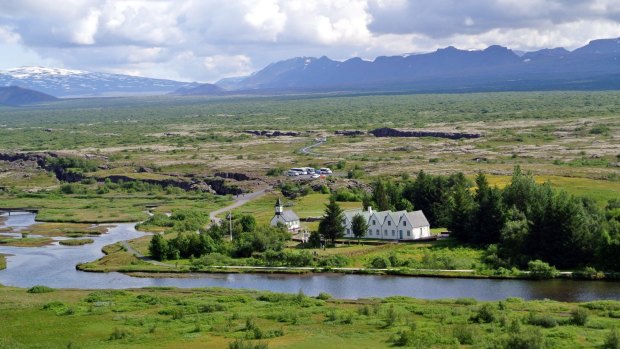
Thingvellir National ParkCredit: Steve McKenna
"Seriously, though, I love coming back to Iceland, and one of the main reasons is because it's never the same. The landscapes are always changing. For example, the steam vents we see are new. Some of the ones that were here last year have dried up. Next year, who knows...."
Having spent the first day of our eight-day Collette 'Inspiring Iceland' tour getting to know Reykjavik, the country's cute, creative capital, we're spending day two navigating Iceland's premier tourist circuit. Comprising a string of eye-catching (and nose-twitching) attractions on a 300 kilometre day-trippable loop from Reykjavik, the Golden Circle apparently earned its moniker from an American news crew, who came to Iceland to cover a ground-breaking 1986 summit between Ronald Reagan and Mikhail Gorbachev. Venturing outside the capital during a break in the talks, the crew ended up reporting on the stark beauty that lay nearby, pretty much undiscovered to most non-Icelanders.
So not only did the summit help end the Cold War, says Jeff; it was also a catalyst for Iceland's fledgling international tourist industry.
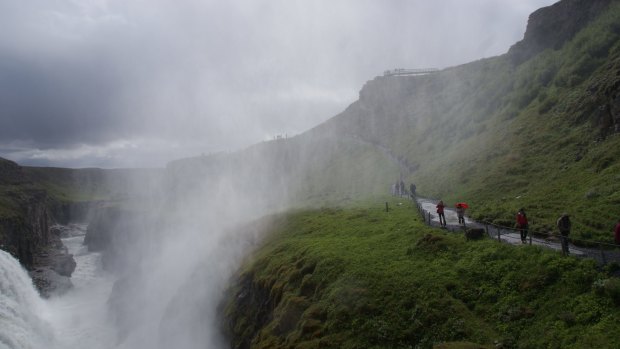
Gullfoss is Iceland's most iconic waterfall.Credit: Steve McKenna
While those soaring steam plumes presented a striking first photo opportunity, our next Golden Circle pit-stop is far more significant. Boasting Unesco World Heritage listed status, Thingvellir National Park nestles in a huge rift valley, where the two continental plates drift apart (now at a rate of about two centimetres per year). Indeed, it's a slightly surreal moment when we cross the plates and Jeff says: "Goodbye North America. Welcome to Europe!". Mother nature has bestowed the park – 23 kilometres east of Reykjavik – with dikes, faults, fissures, rivers and a sprawling, trout-filled lake, beside which Iceland's Viking settlers established what's claimed to be the world's first democratic parliament in AD930.
Little remains of the ancient Althing, as the parliament – which now resides in Reykjavik – is known, but a sleek new visitor centre, a slew of outdoor information boards (and good ol' Jeff) provide nuggets aplenty about this evocative site, a prominent presence in the Icelandic Sagas (the hallowed literature that traces the turbulent lives of the first settlers).
Pulling ourselves away from a mesmerising view of the lake – which is fed with pure glacial water from the Langjokull ice cap – we traverse a walkway that's fringed, on one side, by a sheer fault wall of volcanic basalt and, on the other, by a grassy meadow speckled with buttercups and geraniums.
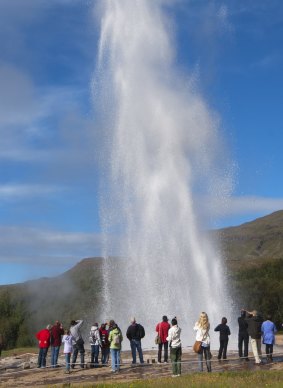
Strokkur geyser erupts on Golden Circle Route.Credit: Getty Images
Jeff brings us to a halt by a fluttering Icelandic flag, which designates the spot where the speaker would announce parliament's new laws, including Iceland's conversion from Norse paganism to Christianity in AD1000. Handily, raised voices were – and still are, as Jeff proves – naturally amplified by the basalt cliff. From this vantage point, we glance over a stream that trickles into the lake and towards one of Iceland's most popular postcard images: an idyllic-looking wooden church, first consecrated in the 11th century (and rebuilt in 1859), and a neighbouring farmhouse, constructed in 1930 to mark the 1000th anniversary of the Althingi's birth. It now doubles up as the park warden's office and the Icelandic prime's minister summer residence. Lovely and tranquil today – even with a few hundred tourists – Thingvellir is rich in eerie myths, legends and gruesome tales that wouldn't be out of place in the Sagas-esque HBO show Game of Thrones (in the Middle Ages, men were burned at the stake here for witchcraft, and women were drowned for offences like adultery and infanticide).
Fittingly, Thingvellir is one of the locations to appear in Thrones – whose producers aren't the only ones to be seduced by Iceland's epic landscapes (and tax breaks). Oblivion, The Secret Life of Walter Mitty, Flags of Our Fathers, Tomb Raider, Die Another Day, Noah, Interstellar, Batman Begins, The Fifth Estate, Thor and Prometheus are among the movies to have shot scenes across 'The Hollywood of the North', as the island's become known.
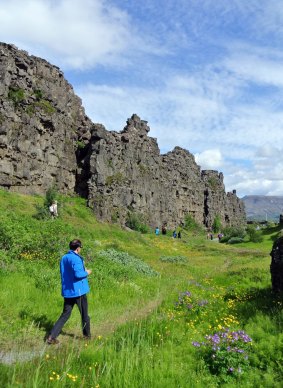
Thingvellir National Park nestles in a huge rift valley.
At our next Golden Circle stop, we see and hear the kind of reactions you'd expect from a cinema audience during an edge-of-your-seat thriller. There are oohs and aahs. Gasps. Screams. Giggles. Even a few tears (from a few terrified toddlers in prams). Such is the arresting power of Strokkur, a geyser so lively it overshadows the Great Geysir – which sits a pebble's throw away, and is the original hot-water spout after which all the world's other geysers are named. While Geysir is fairly dormant nowadays, Strokkur booms into action every five to 10 minutes, firing plumes of steam and water up to 30 metres high, jolting the expectant crowds, who do their best to capture the moment on their cameras, smartphones and tablets. Strokkur looms in the Haukadalur geothermal region, an undulating, sulfur-scented zone of hissing fumaroles and belching mud pots, where numerous visitor facilities have sprouted, including a hotel and spa, a souvenir shop, a restaurant and an audiovisual exhibition explaining the science behind the area's natural attractions and accounts from medieval observers, like the 12th century Danish scholar Saxo Grammaticus.
Moving on, we drive through sheep-and-cottage-blessed countryside that has echoes of New Zealand and Patagonia. We spy snow-dusted mountains, pure-breed Icelandic horses galloping in lush green fields, fishermen knee-deep in streams and futuristic geothermal pipes – which produce much of Iceland's energy supply. Our last major stop on the Golden Circle is arguably the most spectacular: Gullfoss, the country's most iconic waterfall. Boasting a double cascade that drops 32m and spirals down a slim ravine, this ferociously powerful sight is crowned with rainbows on sunny days, and legend has it that you'll find gold here if you look hard enough. One of the theories as to how Gulfoss – which translates to 'Golden Falls' – got its name concerns an ageing farmer, who was so keen for no-one else to inherit his gold that he chucked it into the gushing water.
Heading back to Reykjavik, with the haunting folksy tunes of Icelandic bands Of Monsters and Men and Arstidir drifting through our minibus, we pass a vast, lichen-speckled lava field; the result of an eruption 1000 years ago. I wonder if there are any elves, fairies and trolls hiding in this eerie plain. One of the most peculiar things about Iceland – especially to first-time visitors – is how so many of the country's (mostly well-educated and multi-lingual) population believe in, or at least refuse to deny, the existence of huldufolk (hidden folk). Stories about these mysterious little creatures are passed down the generations, and while outsiders can't help but be sceptical, this is a country that inspires fertile imaginations; the magical scenery, unpredictable tectonic activity and bewildering light sees to that.
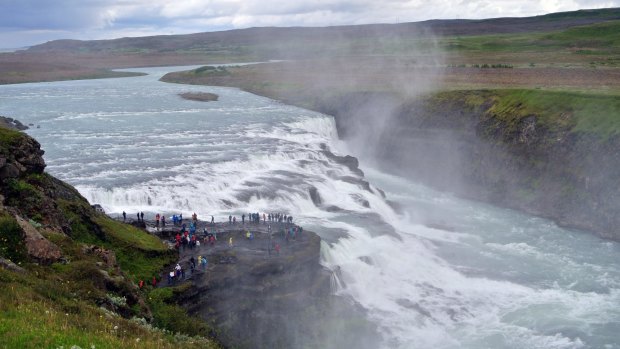
The waterfall at GullfossCredit: Steve McKenna
On my July trip, for instance, the sun barely sets - an experience that's both exciting, yet mildly disorientating. In winter, it barely rises, and, to add to the strangeness, the ethereal aurora borealis (Northern Lights) sporadically ghost through the dark skies. Arriving back in Reykjavik, I feel, like many travellers who complete the 'Golden Circle', content, but slightly restless; desperate to see more of this enchantingly unique island. Thankfully, we have six more days to explore it.
Steve McKenna was a guest of Collette
TRIP NOTES
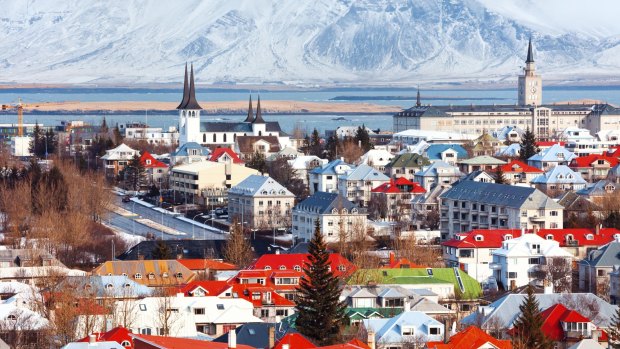
Cityscape Reykjavik, Iceland.Credit: iStock
MORE INFORMATION
GETTING THERE
Travelling directly from Australia to Iceland requires at least two stops. British Airways has a return fare from Sydney to Keflavik (Iceland) via Singapore and London for AUD$2154. Return flights from London to Keflavik with Iceland Air are priced from around $400.
TOURING THERE
Lasting eight days, and including trips to geothermal bathing pools, traditional fishing villages and fjord-skewed peninsulas, Collette's Inspiring Iceland tour is priced from AUD$3,009 per person (based on double occupancy, excluding flights). Collette has 30 Iceland tours in 2016, from May to October; gocollette.com/en-au
FIVE MORE THINGS TO SEE BEYOND THE GOLDEN CIRCLE
1. THE BLUE LAGOON This silica-filled geothermal spa is the place to take a relaxing dip – and envy-inducing pictures; bluelagoon.com
2. LANGJOKULL ICE CAVE Delve into the man-made ice tunnels of one of Iceland's biggest glaciers and, if you're after an unusual wedding venue, tie the knot in its frozen chapel; intotheglacier.is
3. VESTMANNAEYJAR Also known as the Westman Islands, the Vestmannaeyjar archipelago was devastated by a 1973 eruption, but life endures in this southern Iceland outpost, including the world's largest puffin colony; vestmannaeyjar.is/en
4. AKUREYRI Iceland's 'northern capital' has a gorgeous natural setting - by the country's longest fjord – plus a quirky art scene and fine restaurants; visitakureyri.is/en
5. THE EAST FJORDS Drawing just a fraction of Iceland's tourists, this remote, reindeer-dotted region is home to pretty fishing ports, hiker-friendly mountains and bird-watching havens; east.is
See also: The chilled-out way to see Iceland's gob-smacking countryside
Sign up for the Traveller Deals newsletter
Get exclusive travel deals delivered straight to your inbox. Sign up now.